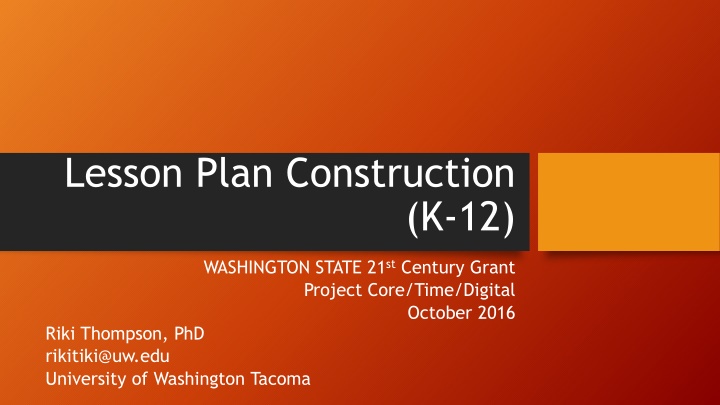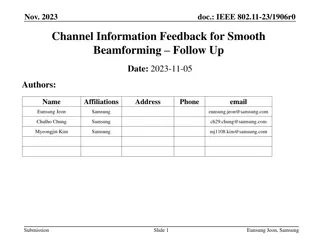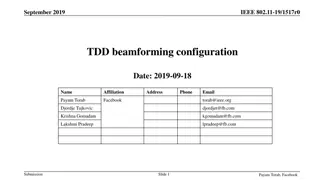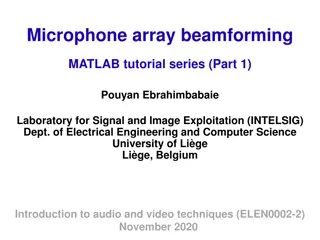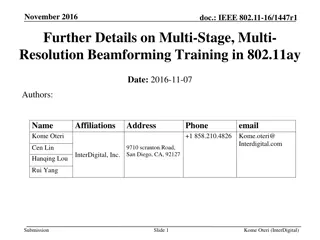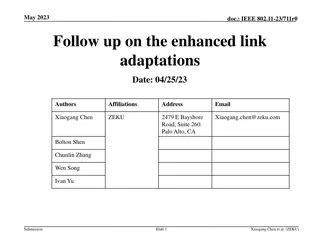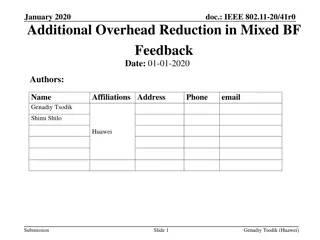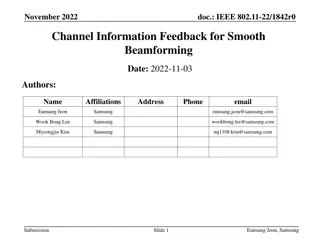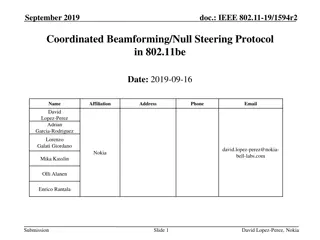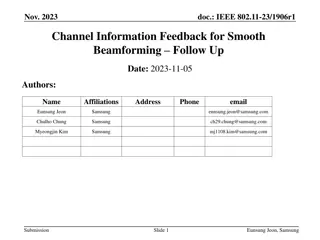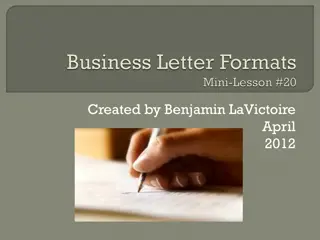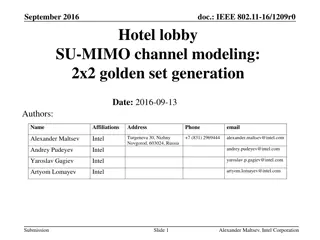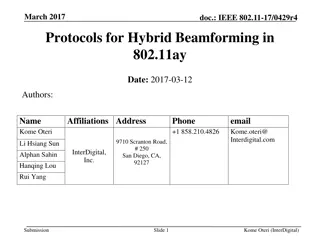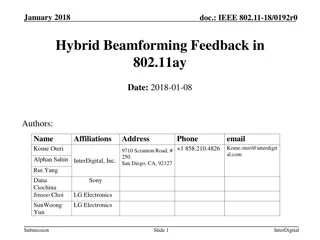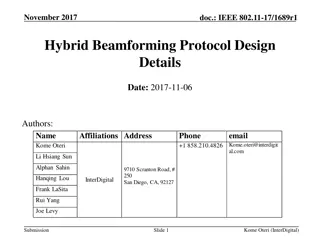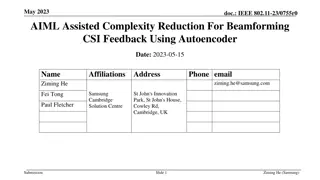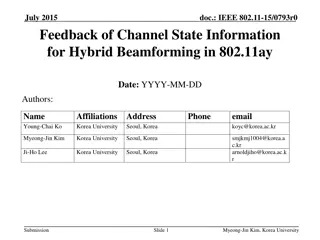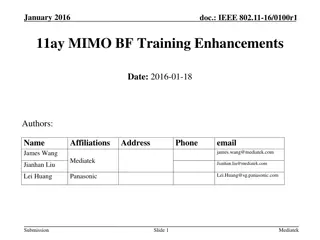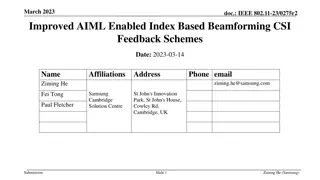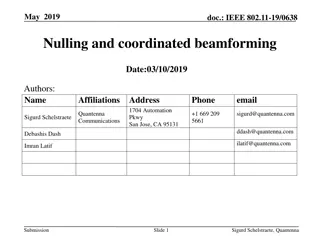Digital Beamforming Feedback Format Proposals in IEEE 802.11-18
This document outlines proposals for digital beamforming feedback formats in IEEE 802.11-18 for both Single Carrier (SC) and Orthogonal Frequency Division Multiplexing (OFDM) systems. It addresses the framework and structure needed for efficient implementation. The presentation discusses the advantages of incorporating digital beamforming alongside analog beamforming, emphasizing the need for a defined feedback format in SC and OFDM systems. Detailed insights into SC and OFDM digital beamforming, including considerations for beamforming matrices and compression techniques, are provided.
Download Presentation

Please find below an Image/Link to download the presentation.
The content on the website is provided AS IS for your information and personal use only. It may not be sold, licensed, or shared on other websites without obtaining consent from the author.If you encounter any issues during the download, it is possible that the publisher has removed the file from their server.
You are allowed to download the files provided on this website for personal or commercial use, subject to the condition that they are used lawfully. All files are the property of their respective owners.
The content on the website is provided AS IS for your information and personal use only. It may not be sold, licensed, or shared on other websites without obtaining consent from the author.
E N D
Presentation Transcript
Lesson Plan Construction (K-12) WASHINGTON STATE 21stCentury Grant Project Core/Time/Digital October 2016 Riki Thompson, PhD rikitiki@uw.edu University of Washington Tacoma
Goals Understand how to use and train teachers to use metacognitive lesson planning Understand formative and summative assessment Understand the key components of formative assessment that are integral to Smarter Balanced Assessment System Introduce Smarter Balanced Digital Library for lesson plan development
Task We are taking a metacognitive approach to take trainers through lesson plan development. As we examine sample lesson plans and create new ones, We will focus on the what, how, why and when, as well as alternatives and options for teaching. Lesson plans will prompt teachers to explain their lesson plans in terms of these four categories, demonstrating their knowledge and providing an explicit roadmap for students and other teachers.
Foundations for learning Metacognitive Lesson Planning Assessment Strategies
Metacognition Thinkingabout thinking Reflectingon one s knowledge and process improves learning
Metacognitive Lesson Planning Declarative knowledge Conditional knowledge Procedural knowledge Differentiation
Declarative knowledge What Describe the content of the lesson This assignment teaches students how to write an argument essay An argument is . An argument must have these main elements
Conditional knowledge Why/When Why students learn content & conditions for use We use arguments to Arguments are especially useful when We also use arguments to
Procedural knowledge How strategy/content Describe the steps for guiding students to acquire the First we will brainstorm, etc. Next, we will Then we will check in Next, we will Finally, we will
Differentiated instruction Options Describe strategies for engaging ELL/Special Ed students Language scaffolding: Graphic Organizers for visual learning, pictures, real objects Cognitive scaffolding: More steps and points to rest and check in, laid out explicitly Cultural scaffolding: Utilize students funds of knowledge from cultural and linguistic background
Metacognitive Lesson Planning What Declarative knowledge Describe the content of the lesson Why/When Conditional knowledge Describe why students learn content & conditions for use How Procedural knowledge Describe the steps for guiding students to acquire the strategy/content Options Differentiated instruction Describe strategies for engaging ELL/SPED students
Foundations for learning Metacognitive Lesson Planning Assessment Strategies
Assessment Strategies: Formative and Summative Instruments for monitoring and evaluating learning
Formative Assessment Monitor student learning & provide ongoing feedback used by instructors to improve their teaching recognize where students are struggling and address problems immediately used by students to improve their learning identify strengths and weaknesses and target areas that need work
Tips for Formative Assessment low stakes= low or no point value Examples Concept maps to represent understanding of a topic One or two sentences identifying the main point of a story A rough draft for early feedback
Check in What is formative assessment?
Understanding the Formative Assessment Process Smarter Balanced Assessment Consortium
Step 1. Clarifying Intended Learning The teacher identifies the instructional goal, communicates the goal to students, and provides the criteria by which learning will be assessed so each student and the teacher knows whether the student is successfully progressing toward the goal. Define learning goals clearly using student-friendly language as such I can .
Step 2. Eliciting Evidence After a period of instruction, the teacher checks for students understanding. This could be the first draft of an essay, a ticket out the door, an answer to a question on a white board, pair-and-share observations, or a paragraph on how to solve a mathematics problem.
Step 3. Interpreting the Evidence The teacher and each student interpret the evidence and reflect on the student s progress toward the learning goal. Evidence is interpreted throughout instruction, checking in throughout the process. Students can also analyze evidence of their own learning, but also benefit from discussing interpretations with others.
Step 4. Acting on Evidence The teacher makes adjustments to the ongoing instructional activities, while students also adjust their procedures for learning. The teacher and students continue to use strategies that work and eliminate strategies that are not effective
Check in What is are the four components of formative assessment?
Smarter Balanced Digital Library A Colorful Writing Self-Assessment | Author: Georgia Brooke, Heidi Andrade Ed.D. Owner: A Jobs for the Future Project: Students at the Center
Exit Slips help students reflect on what they have learned and express what or how they are thinking about the new information. Exit Slips Exit Slips easily incorporate writing into your content area classroom and require students to think critically. (AdLit.org,http://www.adlit.org/strategies/19805/)
Tips for Exit Slips Types of prompts Other exit prompts include Document learning I would like to learn more about Please explain more about The most important thing I learned today is The thing that surprised me the most today was I wish Ex. Write one thing you learned today. o Ex. Discuss how today's lesson could be used in the real world. o Emphasize the process of learning Ex. I didn't understand o Ex. Write one question you have about today's lesson. o Evaluate the effectiveness of instruction Ex. Did you enjoy working in small groups today? o Fisher, D., and Frey, N. (2004). Improving Adolescent Literacy: Strategies at Work. New Jersey: Pearson Prentice Hall.
Check in What are some of your formative assessment strategies?
Final Assessment Instruments for evaluating student learning Types of evidence used in summative assessments include: Essay SBAC interim assessment Report Rubrics Problem Sets Presentations Performance assessment Graphic Organizers Performance task
Lesson Plan Analysis Foundational CCSS standards Lesson Objectives 1. Pick a lesson plan to analyze (ELA, Math, Science) 2. Apply your understanding of lesson plan construction to a sample lesson plan Metacognitive Declarative knowledge Conditional knowledge Procedural knowledge Differentiation 3. Identify components from our lesson plan template & take notes on the sample Assessment Formative Summative 4. Compare what you found with your neighbors
Before we exit Pick the prompt that most resonates with you about this session I would like to learn more about o Please explain more about o The most important thing I learned today is o The thing that surprised me the most today was o
